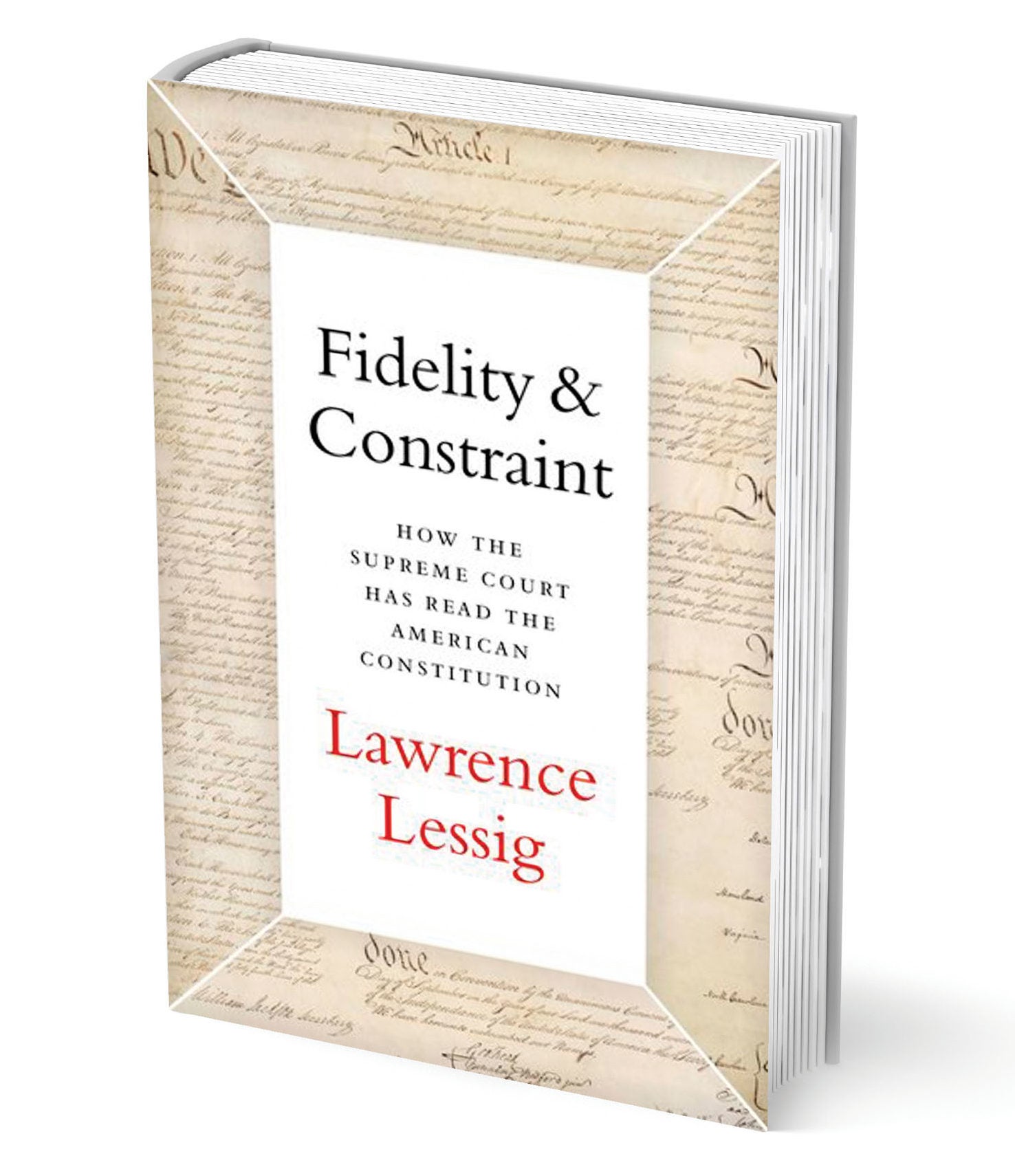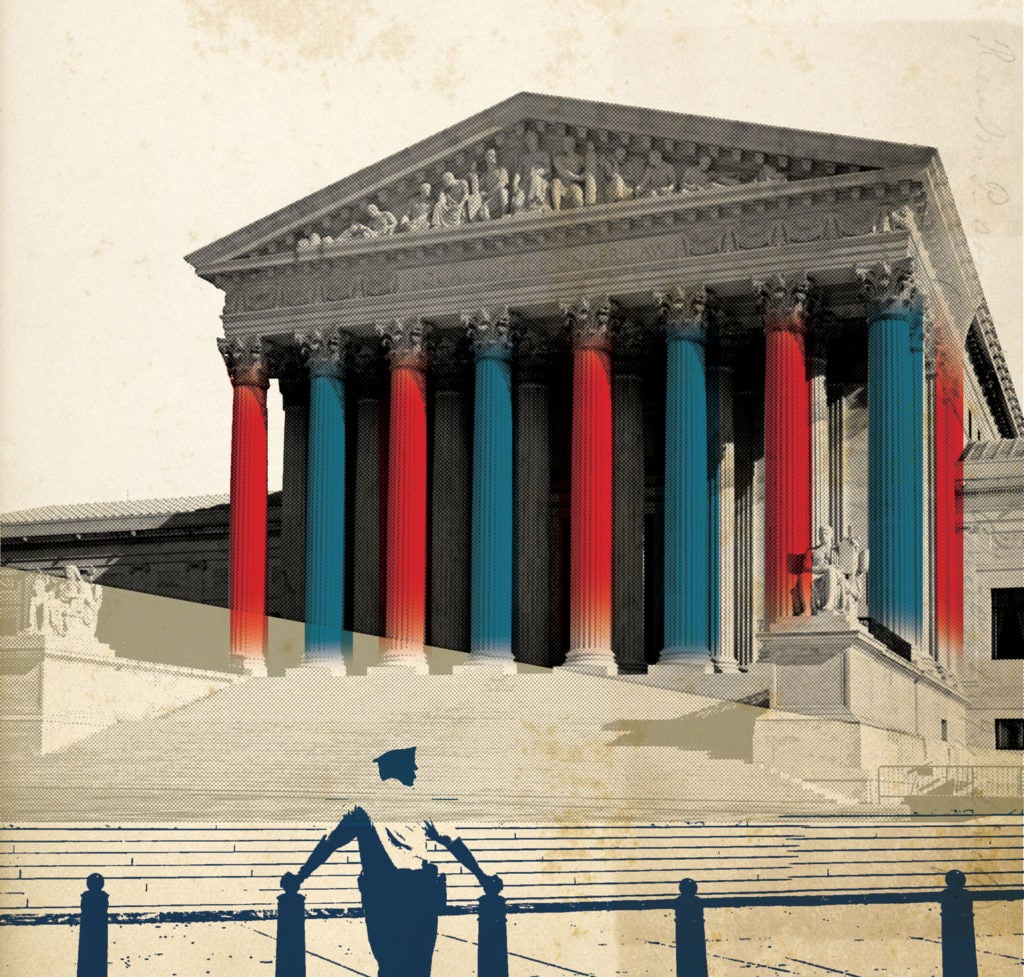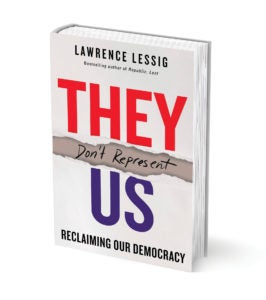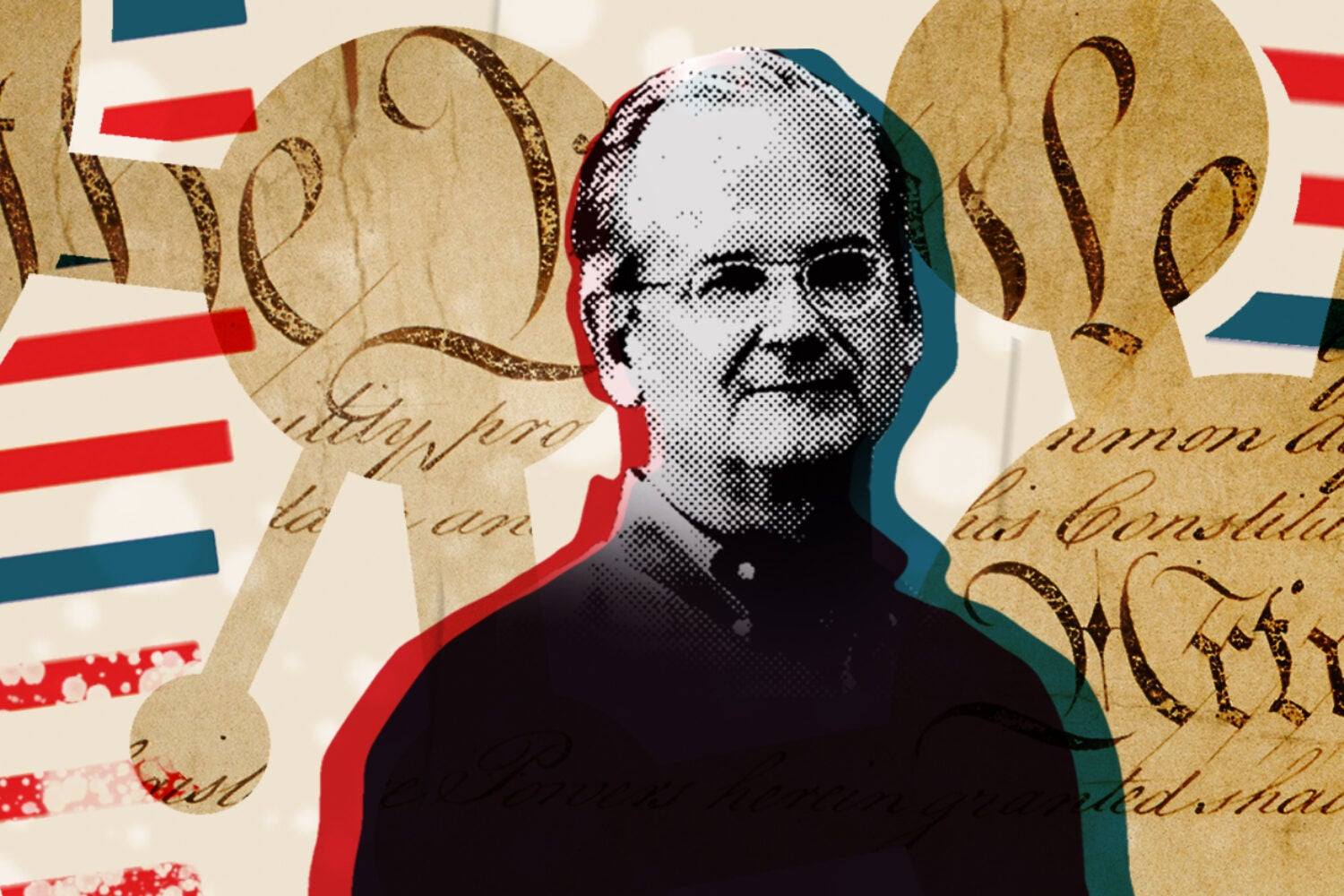At the start of his recent book “Fidelity & Constraint: How the Supreme Court Has Read the American Constitution,” Harvard Law Professor Lawrence Lessig asks the reader to assume “the very best of the justices.” He writes: “Put your politics in a box and lock it away. Don’t approach this story from the Left or the Right; approach it as an enlightened anthropologist would, and listen, engage, and try to understand it as the work of judges trying to do the best they can do at the time in which they work.” That is a startling requirement, for it seems to ignore lessons about the pervasive effects of America’s unruly politics on the legitimacy of our core institutions, including the Court. Lessig has campaigned intensely against these threats to democracy, and in the process he has become an intellectual celebrity.
Lessig has courted attention as part of a crusade to curb the corrupting influence of money in politics. His prominence spiked in January 2014, when he started on a 190-mile walk of protest from north to south through the state of New Hampshire, as the site of the nation’s first presidential primary every four years. In May that year, with Mark McKinnon, a Republican political strategist, Lessig took another step and founded a super PAC now called Mayday America. It began as a grassroots effort to elect a Congress that would pass reforms limiting the dominance of big donors in politics. Its goals have broadened to include defending voting rights of minorities and ending partisan gerrymandering, as part of a quest to save American democracy.
Lessig first launched his crusade to curb the corrupting influence of money in politics after the Supreme Court’s ruling in Citizens United
That moved Lessig to enter the race for the Democratic nomination for president in the 2016 election. He pledged to be a “referendum candidate”: He would resign as president if Congress passed “a package of fundamental reforms that would crack the corruption that had captured our government.” The promise proved to be a major distraction, as he recounted on the New Yorker website: It helped “sink the campaign,” which ended shortly afterward. What guaranteed its end, he wrote, was the decision by the Democratic National Committee to retroactively change the rules about when a candidate had to qualify to be permitted to participate in a presidential debate, effectively excluding Lessig from the stage. A friend wrote him, “And thus was Larrymandering invented.”
In late 2016, Lessig founded a new nonprofit, nonpartisan group called Equal Citizens “to fix democracy by establishing truly equal citizenship.” Through the organization, his latest effort in helping fix democracy is a petition asking the Supreme Court, in review of contradictory rulings from the states of Washington and Colorado, to address the workings of the Electoral College. (He organized a related conference on the topic at HLS in the fall.) He called the mechanism one of the “least understood disasters at the core of our Constitution,” which, five times in American history including in 2016, has chosen a “president based on an unrepresentative minority.”
In “Fidelity & Constraint,” Lessig describes justices on the Right and the Left, who are guided by a fidelity to the Constitution and to the institution of the Court.
With the lawyer David Boies, who represented former Vice President Al Gore in Bush v. Gore, Lessig and Equal Citizens are also spearheading several lawsuits to persuade the federal courts to apply the principle of one person, one vote to the Electoral College. The goal is to have each state allocate its electors proportionately, so the percentage of electors from a state voting for a candidate is the same as the percentage of voters for the candidate in the state.
Lessig immersed himself in politics in large part because of the Court’s momentous 2010 ruling in Citizens United v. Federal Election Commission. By a vote of 5-4, with the conservatives in the majority and the liberals in dissent, the Court struck down restrictions on independent spending of corporations, unions, and other organizations in political campaigns—spending not coordinated with campaigns, yet about issues important to them. The conservative majority also affirmed the view that money equals speech. That makes regulation of spending on politics a matter of free speech protected by the First Amendment, so only a compelling interest of the government can justify the regulation.

The Court recognized combating political corruption as a strong interest that justifies limits on campaign spending. But as Lessig wrote in the Boston Review, the “only corruption the Court found that justifies suppression of political speech is ‘quid pro quo’ corruption”—trading a political favor for money or some other benefit. There was no evidence of that in Citizens United because, as a result of the unusual nature of that litigation, there was no evidentiary record in the case.
He called the quid-pro-quo understanding of corruption “extremely narrow and mistaken.” It ignored “institutional corruption,” what he describes as “an influence, financial or otherwise, within an economy of influence, that weakens the effectiveness of an institution, especially by weakening public trust in that institution.”
Lessig has done extensive research on the conception of corruption held by the framers of the Constitution. Of 325 recorded uses of the term in 18th-century debates about the Constitution’s creation and ratification, he and colleagues found, 56% referred to corruption of an entity like a representative body, such as Congress; 44% referred to corruption of individuals, including the quid-pro-quo kind. When Lessig submitted this research to the Supreme Court in 2013 in an amicus brief, he argued that the Constitution’s framers had “a very specific conception of the term ‘corruption’ in mind.” They were especially concerned about “improper dependence” of institutions, like Congress, in an economy of influence. For Lessig, the brief emphasized, “The Framers viewed corruption as one of the greatest threats to government.”
“Fidelity & Constraint” is a surprisingly admiring account of the workings of the Court. Lessig makes the case that justices with opposing philosophies have used the same method to decide cases. Conservative justices, to safeguard liberty, have limited the power of government to regulate the economy. Liberal justices, to protect the same value, have limited the power of the government to regulate social behavior. He describes how justices on the Right and the Left have reached different kinds of results that matter to them, by interpreting the Constitution with fidelity to its text and with fidelity to their role—to the institutional responsibility of the Court.
These fidelities make up a two-step process of interpretation, which, together, he writes, “make understandable the twists in the history of that institution that are otherwise suspicious.” During the four decades from the end of the 19th century through the Great Depression, for example, when justices in the Court’s conservative majority favored what they called liberty of contract (others called it laissez-faire economics), they demonstrated their fidelity to meaning as they read the Constitution.
The switch in time that saved nine, as it’s often been called, occurred when the unpopular Court of the 1930s stopped striking down legislation passed to help revive the American economy during the New Deal. That switch, according to Lessig, is “the most difficult challenge for constitutionalists trying to justify the practice of American constitutional law across its history.” If the Court’s many rulings reflected its faithfulness to the Constitution’s meaning, how did these reversals fit? They didn’t, he writes. Instead, they reflected “fidelity to role,” in his words. That pushed “the Court away from fidelity to meaning,” to concentrate instead on hewing to the role the framers had in mind for it as the least dangerous branch, which should generally be deferential to the legislative and executive branches.
Lessig expresses fear that the nation is not far from a time when the Court will be “perceived by us all to be political.”
A choice about law that a justice faces arises about facts reflecting a specific moment in time, Lessig goes on, so the context of the choice, or the context’s “social meanings,” enable and constrain the justice’s application of both fidelities. Lessig calls himself a two-step originalist, though his brand of originalism allows a justice interpreting the Constitution to read it in a way that fulfills what he understands its purpose to be, going beyond what a one-step originalist would see as its meaning.
A one-step originalist, as he writes, “understands the text in its original context.” Lessig’s second step of originalism involves carrying “that first-step meaning into the present or target context.” Lessig clerked for the late Supreme Court Justice Antonin G. Scalia ’60, a champion of originalism, who famously called himself a “fainthearted originalist.” Lessig quotes him as saying in that spirit, “I am an originalist, but I am not a nut,” meaning Scalia would not defend an understanding of the Constitution’s framers that, as Lessig puts it, “most people” in the 21st century would deem “crazy” based on strong precedential, moral, or other considerations.

The two steps of Lessig’s originalism are different from the two steps of his theory of constitutional interpretation, yet they make up an essential element of that process. His is a golden-mean theory, between the rigidity of one-step originalism, which is at once influential and often challenged as a school of interpretation, and the elasticity of the concept of the living Constitution. The practice of this two-step process involving fidelity to text and to role has made the Court “an extraordinary institution within our constitutional tradition,” Lessig argues, working closer than either Congress or the executive branch to “the Framers’ design.”
Mention of Citizens United appears in “Fidelity & Constraint” only on the second-to-last page of the body of the book. Lessig implies there, without spelling it out, that the corruption of government, which has preoccupied him for the last decade, has affected the Supreme Court as well and that the ruling in that landmark case is an important piece of evidence supporting his view. When former Harvard Law School dean, now-Justice Elena Kagan ’86 replaced John Paul Stevens on the Court in August 2010, it was the first time in American history that the institution’s ideological divide was between justices picked by Republican presidents (the conservatives) and by Democrats (the liberals).
Lessig writes that the nation has “allowed partisan norms to infect the institution of the judiciary.” He expresses fear that the nation is not far from a time when the Court will be “perceived by us all to be political.” He says that “the practice of constitutionalism,” which his book celebrates, “will not survive” if “justices are openly appointed to reverse the decisions of an earlier Court,” like in Citizens United, and “if the perception that the work of the Court is only and always inherently partisan continues to climb.” He is bluntly pessimistic about those ifs.
You might expect an ambitious scholar this alarmed about partisan norms infecting the judiciary to address that development fully in his major work about how the Court decides cases. Lessig does not. The book is full of the context of cases decided over hundreds of years, of course. But the background for any major book about the Court today is the extreme turbulence in American politics, which Lessig has brilliantly schooled us to regard as a primary threat to the nation’s governance. A book about fidelity to the Constitution that touches on Citizens United only as an afterthought has not addressed or explained the peril of a critical context for today’s Court decisions, which Lessig acknowledges.
One explanation for this omission comes in the book’s afterword: Lessig began the book back in 1997. Then 36, he had published a law review article called “Fidelity and Constraint,” put the project aside, and became a star in the legal academy because of his pathbreaking work on the internet. After returning to the Court book “from time to time,” he decided to publish it now, at 58. In a recent conversation about the book for this article, he emphasized what he wrote at the end of it: “I’ve got to bring it to a close and get it published, because I’m deeply anxious about whether the Constitution and the Supreme Court, as I’ve conceived of it, will survive.”
“If I had to make the argument that the Court and the Constitution will survive, it would put Chief Justice Roberts as the number one reason.”
Another explanation comes in a second book Lessig published in 2019, “They Don’t Represent Us: Reclaiming Our Democracy.” “Fidelity & Constraint” is the equivalent of a dazzling academic lecture, for scholars, law students, and lawyers who closely follow the Court. With incisive prose and intellectual virtuosity, Lessig presents an ingenious framework and an intricate theory for understanding the Court’s work. The book has a timeless quality. “They Don’t Represent Us” is the equivalent of a super TED talk, for anyone concerned, as he writes in the preface, that the “crisis in America is not its president,” meaning Donald Trump, because the “president is the consequence of a crisis much more fundamental.” The second book is about the context for the first.
Lessig argues that the state of American democracy today is as vulnerable as that of Communism just before it collapsed in the Soviet Union, because democracy now caters to the nation’s elite and no longer works for the demos—the people. The book contains a mea culpa. In the past decade, he says, it was a mistake for him to call money “the root to the problems of this Republic.” Campaign funding is a problem, he writes, but as “just one example of a more fundamental problem: unrepresentativeness.”
In “They Don’t Represent Us,” Lessig argues that American democracy today is as vulnerable as Communism was just before it collapsed in the Soviet Union.
Voting doesn’t represent citizens equally, because the clear effect of expanded requirements of voters, like voter-identification laws, has been to diminish participation of Democrats, especially minorities, with little deterrence of Republicans. So-called representatives, like members of Congress, don’t represent citizens equally because gerrymandering of districts favors candidates with extreme positions in primaries and drives out moderate politicians who would represent moderate voters. The Senate, by definition, which has two members from each state, heavily favors small states over big ones and, because of Senate rules, allows 41 senators representing only 10% of Americans to block legislation backed by 90%. The Electoral College, which has a 20% likelihood of picking a president who loses the popular vote in a close election, gives older, whiter voters added influence because they dominate in swing states, which determine the outcome of presidential elections.
The upshot is a government that no longer addresses the country’s biggest challenges, Lessig argues. For two decades, a majority of Americans have recognized climate change as a crisis, but Congress has failed to take comprehensive action. The American Society of Civil Engineers says that the country’s infrastructure is “mostly below standard,” but Congress has yet to deal with the problem on the scale it requires. The economy buoyantly serves a narrow segment of the population, while ill-serving the vast majority, because the weakest part of the economy is now the political system that shapes it, which favors that elite. Fixing deep structural flaws of the economy requires major changes in national public policy. The incapacitating corruption of the political system now makes those changes impossible.
“I am a populist who does not rage. I feel the emotion of this moment as fully as any. But the fearful urgency of now calms me.”
In “They Don’t Represent Us,” Lessig explains why this calamity has happened—why (quoting the scholar Kirby Goidel) “‘We the people’ are simply not up to the task of self-governance.” The heavy reliance of American media on advertising revenue pushes them to favor content that attracts eyeballs, rather than the kinds of facts and opinions citizens need to make informed choices about politics, policies, and public affairs. In addition, the unifying source of information that Americans had when the broadcast media of radio and television reached a high percentage of news consumers has given way to narrowcasting and fragmentation in the digital age. Many more sources of content now compete for consumers’ time and attention. Consumers can choose what to tune in to and what to tune out. They inhabit bubbles reinforcing their biases. “On many issues,” Lessig writes, “we are fundamentally divided, in part because our values are different, but in the main because our understanding of the facts is radically different. What ‘we know’ we won’t know in common. And that fact affects fundamentally how we get represented.”
The bubble problem besets the Supreme Court, buffeting its legitimacy. In June 2019, when the Supreme Court blocked the Commerce Department from adding a question about citizenship to the 2020 census, Mark Levin, an extreme and influential conservative commentator about the Court, tweeted to his 1.76 million followers, “John Roberts becoming a laughingstock as a Chief Justice.” Levin has the force of conservative populism on his side.

In “They Don’t Represent Us,” Lessig writes: “I am a populist who does not rage. I feel the emotion of this moment as fully as any. But the fearful urgency of now calms me.” A third explanation why Lessig didn’t include much about Citizens United in “Fidelity & Constraint,” he said, is that the ruling’s ideological nature doesn’t set it apart. While “you could say that there’s a deep ideological frame to everything the Court does,” one of the points of the book “is to get a reader to recognize the way that deep ideological frame has constantly affected the way the Court bends the law or just shifts the direction of the Constitution.” He doesn’t think the Court is corrupt in the sense that he’s “describing Congress as corrupt,” nor does he think the ruling “is a product of corruption.” In time, he expects the Court to revise its views about regulation of campaign finance.
If he could add a case to “Fidelity & Constraint,” he said, it would be the subject of Levin’s laughingstock tweet, Department of Commerce v. New York. There, by 5-4, the Court found that the reason the secretary of commerce gave for including that question about citizenship “seems to have been contrived.”
Chief Justice John G. Roberts Jr. ’79 wrote the opinion of the Court. Its four liberal justices supported the section of the opinion about the secretary’s pretext. According to Lessig, “It’s quite clear that the citizenship question represents the grossest kind of manipulation for partisan reasons, and the Court just wasn’t going to be a party to it.” He went on to say that the chief justice did that “for the kind of fidelity-to-role reasons that I am trying to elevate as central to our understanding of the Supreme Court”—to institutional responsibility.
“I’m a big fan of Roberts’,” he said, “not because I like his politics but because I think that he’s a deeply institutional chief justice. If I had to make the argument that the Court and the Constitution will survive, it would put Chief Justice Roberts as the number one reason.”
